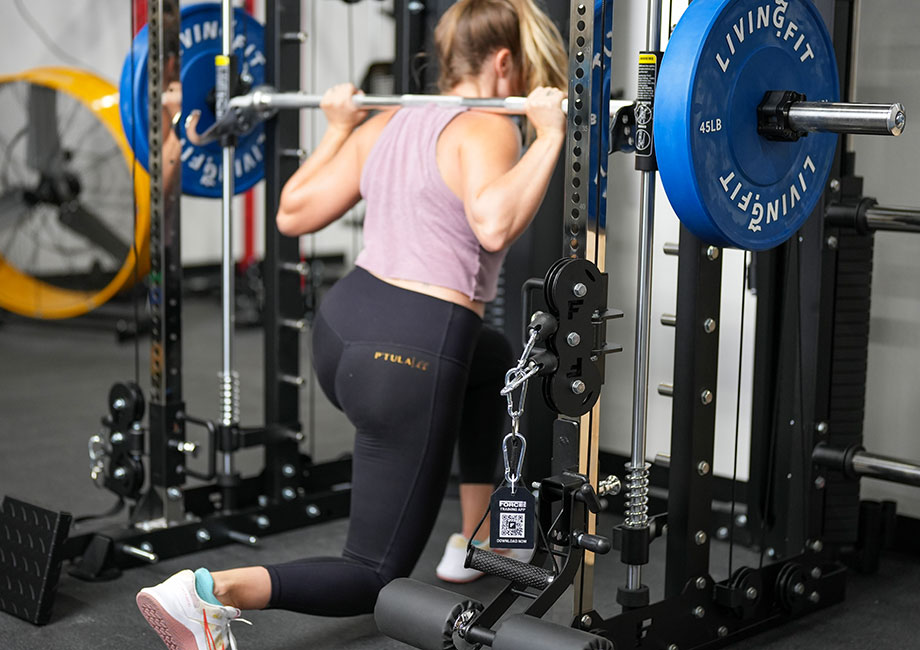We test and review fitness products based on an independent, multi-point methodology. If you use our links to purchase something, we may earn a commission. Read our disclosures.
It’s hard to beat the standard squat when it comes to lower body exercises. This barbell classic provides muscle activation throughout the entire body, predominantly hitting the glutes, quads, hamstrings, and calves, as well as upper body muscles like the shoulders, lower back, and core.
The barbell back squat reigns supreme, but that certainly doesn’t mean it’s the only movement worth doing during your leg day workout routine. There are loads of leg exercises to consider, including the tried-and-true single-leg hybrid that looks like a mix between a squat and a lunge.
You guessed it; we’re talking about the split squat. Amanda Capritto, CPT, CES, CNC, CF-L1, CSNC, provides everything you need to know about this unilateral exercise. Read on!
How to Do Split Squats
- From a standing position, step back with your right foot to enter a split stance.
- Slowly lower your body towards the floor, keeping your chest tall, core tight, back straight, and eyes forward. Continue until your knees form 90-degree angles.
- Pause, then drive through the heel of your front foot to return to the starting position.
- Complete the desired number of reps, then step the left foot back and repeat the set.
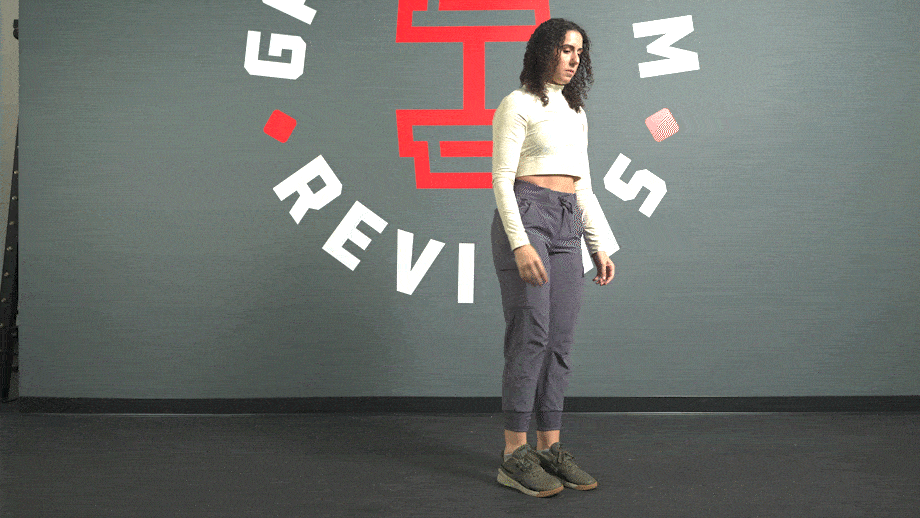
Trainer Tips for Form
The split squat seems simple, but they still may throw beginners for a loop. Here are a few cues to keep in mind when learning proper form and performing the split squat exercise.
Perfect Your Foot Positioning
The perfect foot positioning during a split squat makes this movement look majestic to onlookers in the gym, but it’s about much more than aesthetics.
“A narrow split squat stance places additional stress on the knee joints,” says Amanda Capritto, CPT, CES, CNC, CF-L1, “while a split squat stance that’s too wide reduces the range of motion of the exercise and puts you at risk for hip hyperextension.”
So, perfect foot positioning is a must, but how can you be sure you have it down pat?
“Step back into a reverse lunge. Your front knee will form a 90-degree angle and your back knee will lightly touch the floor,” says Amanda. “Now, step your back foot farther back, and do another reverse lunge, repeating this until your back knee no longer touches the floor. Once your back knee stops touching down, step your rear foot back to the last location where your knee did touch the floor, because you do want it to touch the floor during the split squat, and that’s your stride length.”
When in doubt, don’t be too shy to consult a certified personal trainer, coach, or other qualified fitness professional. If you don’t know where to start, check out our roundup of the best online personal trainers.
Distribute More Body Weight to Your Front Leg
It’s called a split squat, but the movement does bear a striking semblance to the lunge. And, like the lunge, you’re going to have your front leg bear the brunt of the work.
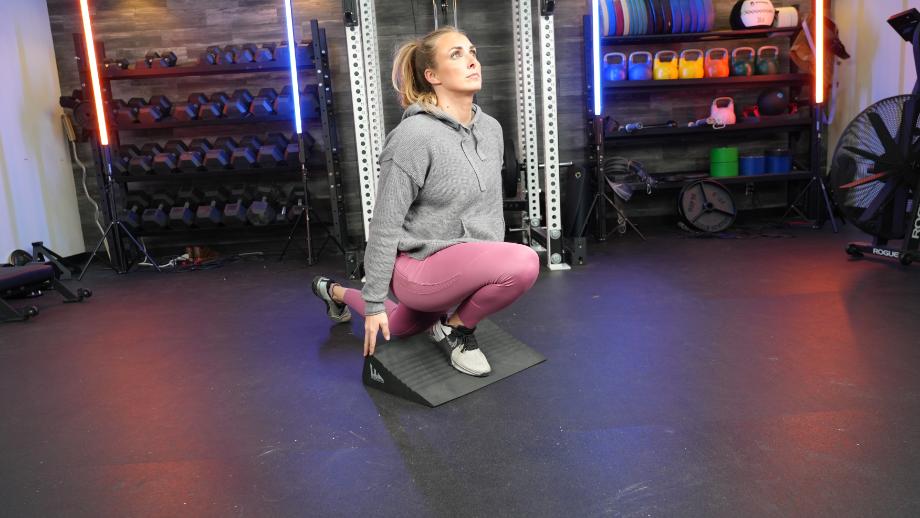
RELATED: Lunges Exercise
To properly utilize the muscle groups in your front leg, you’ll want to keep most of your body weight on your front leg, specifically by shifting your weight to the heel. And, like your regular squat, you’ll get back to a standing position by driving through the heel of that front foot.
Maintain a Neutral Spine
Maintaining good posture is important when you’re performing bodyweight split squats, but it’s even more crucial if you’re racking a loaded barbell on your shoulders or holding a pair of the best dumbbells as you get in your reps.
“Both rounding and arching the back take your spine out of alignment and increase your risk of injury,” says Amanda. “This commonly happens when you’re losing tension during the range of motion, either from fatigue or insufficient core strength.”
So, how do you make sure you’re maintaining neutral positioning with your neck and spine?
“Start by getting into your split stance, then check in with your upper body. Make sure your chest is tall, core is braced, back is straight, and eyes are facing forward,” adds Amanda.
Work on Hip Flexor Mobility
Squats and squat variations are already known to target hip flexors and adductors, but the split squat places even more emphasis on these muscles due to the unique staggered stance.
RELATED: Hack Squat
That’s good news for the more limber folks among us who are already capable of an impressive range of motion, but others may find out firsthand that their muscles are much tighter than they knew.
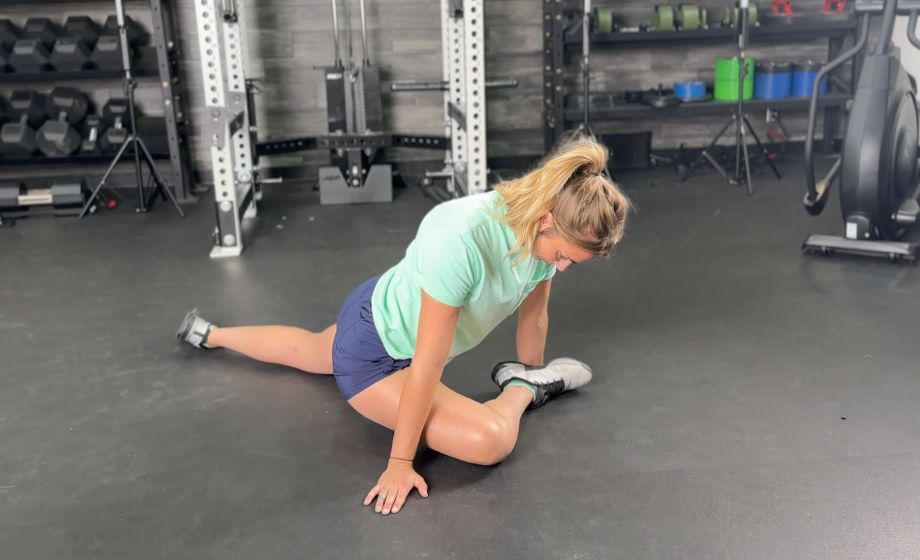
“Hip mobility exercises are a great way to improve flexibility, mobility, and stability, and they’ll translate directly to your split squat performance,” says Amanda. “Working a few mobility exercises before your working sets may help you perform the split squat with greater ease or lift heavier weights if using resistance.”
RELATED: Hip Flexor Exercises
Common Split Squat Mistakes
So, what kinds of things should you try to avoid when performing this single-leg strength training movement? Here are some of the most common split mistakes to avoid.
Feet Too Close Together
Perfect foot positioning ensures a healthy range of motion, providing you the most bang for your buck on each rep while minimizing the amount of stress on your precious joints.
Keeping your feet too close together, on the other hand, gives you a less stable base to work with, causing balance issues that could be catastrophic if you happen to have a heavy barbell racked on your back during the rep.
RELATED: Balance Exercises
A narrow stance also places strain on your joints, specifically your knees and ankles, which may contribute to or cause an injury.
To prevent an overly narrow stance, use the reverse lunge trick—that Amanda details above—for determining your perfect stride length. Working with a certified personal trainer never hurts, either.
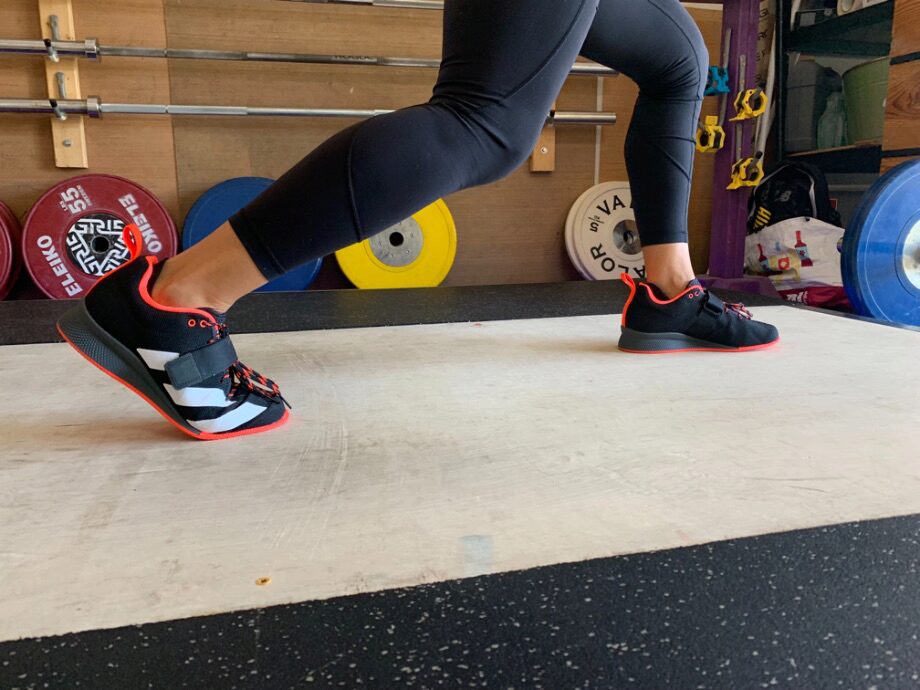
Feet Too Far Apart
A stance that is too wide is equally problematic. Like a narrow stance, a wide stance could offset your balance and make it difficult to maintain good posture and neutral alignment. Wider stances also reduce the range of motion, diminishing the impact of each repetition.
The most notable issue with placing your feet too far apart, however, is the increased risk of hip hyperextension, which may lead to joint pain, dislocation, and other complications.
“During the split squat, the shoulder, hip, and back knee are vertically stacked. This minimizes the shear forces on your joints and reduces your risk of injury,” says Amanda. “If your feet are too far apart, the knee of your back leg is out of alignment, which causes the hips to move in a way that’s unnatural.”
So, to make sure your stance is spot on, try using the reverse lunge trick, and don’t forget that the back knee is meant to touch the floor. If you’re not reaching the floor with your back knee, it’s a near guarantee your stance is too wide.
Torso Falling Forward
Good posture and neutral alignment are important in many strength training exercises, including deadlifts, the overhead press, and, you guessed it, squats like the split squat. To maintain that picture-perfect posture, you’ll need a tall chest, a tight core, a straight back, your shoulders pulled down and back, and your eyes fixed forward.
“Many of us lose tension in our torsos when the going gets tough, and it causes us to round the back and lose neutral alignment,” says Amanda. “Hunching forward during split squat reps places undue stress on the spine, which may lead to back pain, strains, herniations, and more.”
If you’re having a hard time keeping your posture strong throughout your set, consider reducing the number of reps per set, using lighter weights, performing reps using bodyweight only, or supplementing your lower body workouts with functional core exercises to improve core strength.
Split Squat Variations
Are you already a pro at bodyweight or standard split squats? Then, how ’bout you try these split squat variations on for size!
Bulgarian Split Squat
The regular split squat has its merits, but elevating your rear leg converts it into the Bulgarian split squat, a movement often lauded as one of the best single-leg exercises in existence.
The BSS targets many of the same muscles as the standard back squat. According to a study in the Journal of Strength and Conditioning Research1, it provides greater activation to the hip flexors compared with the conventional back squat.
Another study, published in the International Journal of Exercise Science2, found that the BSS was much gentler on the knee joints as well, making it a viable alternative to the standard back squat for individuals working around pre-existing knee issues or injuries.
Here’s how to perform the BSS with proper form:
- Set up a flat weight bench behind you and place one foot on it.
- Lean into your front leg, bending it as you slowly lower yourself into a squat.
- Continue until your front knee forms a 90-degree angle.
- Hold the position briefly, then push through the front heel to stand.
- Repeat as needed, then switch sides.
RELATED: Best Weight Bench
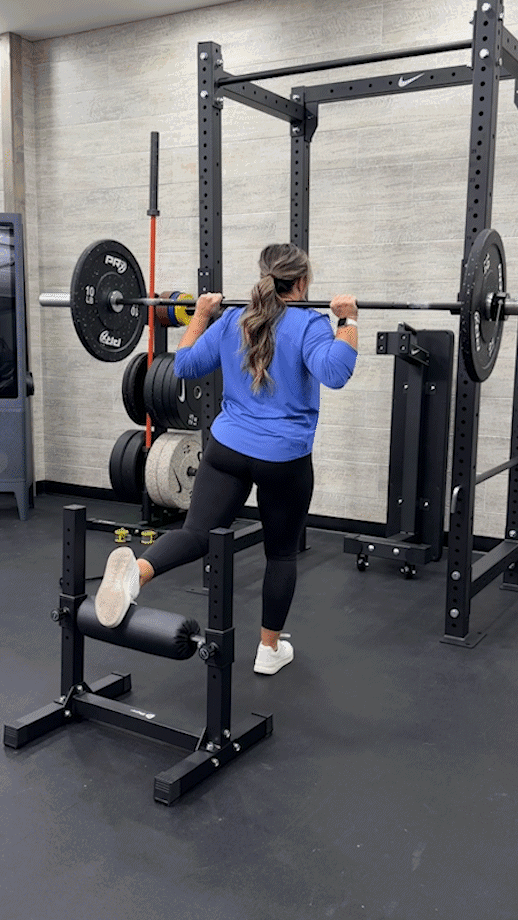
Smith Machine Split Squat
Once you’ve mastered the bodyweight split squat, it’s time to start adding resistance to progressively overload your muscles and really start raking in the gains.
A Smith machine is a great way to accomplish this, as the machine’s fixed bar path forces you to maintain a proper vertical movement pattern from start to finish. Smith machines also incorporate various safety features in the event something goes wrong.
To perform the split squat using a Smith machine, set your bar to shoulder height, rack the desired amount of weight, unrack the bar onto your upper back and shoulders, and perform the exercise as per usual.
- From a standing position, step back with your right foot to enter a split stance.
- Slowly lower your body towards the floor, keeping your chest tall, core tight, back straight, and eyes forward. Continue until your knees form 90-degree angles.
- Pause, then drive through the heel of your front foot to return to the starting position.
- Complete the desired number of reps, then step the left foot back and repeat the set.
RELATED: Smith Machine Leg Workouts
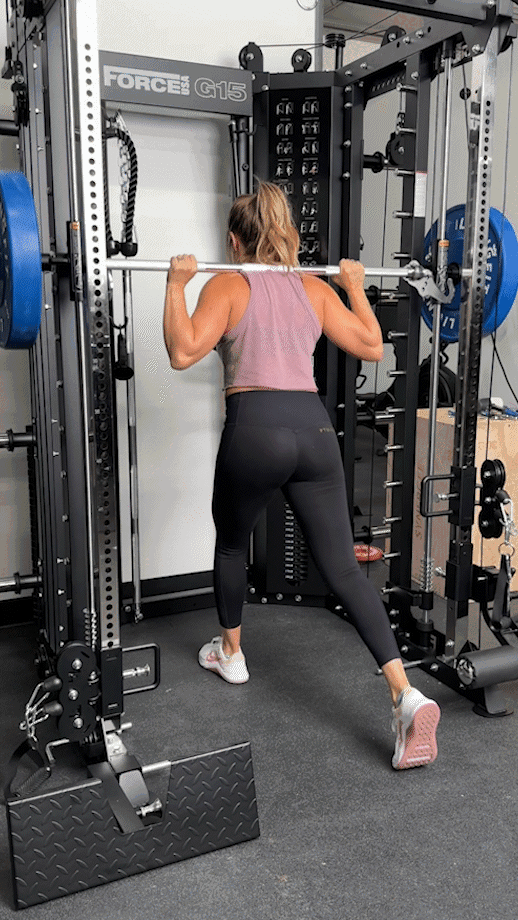
Weighted Split Squats
Smith machines aren’t the only way to add weight to your split squat. Free weights, including barbells, dumbbells, and kettlebells, all make viable options for including resistance in your split squat sets:
- Standard Barbell Split Squat: Adjust your rack to shoulder height, load the bar, unrack it onto your upper back and shoulders, and you’re good to go!
- Suitcase Split Squat: Hold a dumbbell or kettlebell in each hand with arms fully extended at your sides, set up as you normally would, and start squatting.
- Goblet Split Squat: Hold a dumbbell or kettlebell to your chest during your reps.
As with all weightlifting exercises, be sure to warm up with a few light sets before getting into your working weight.
RELATED: Best Warm-Up Exercises
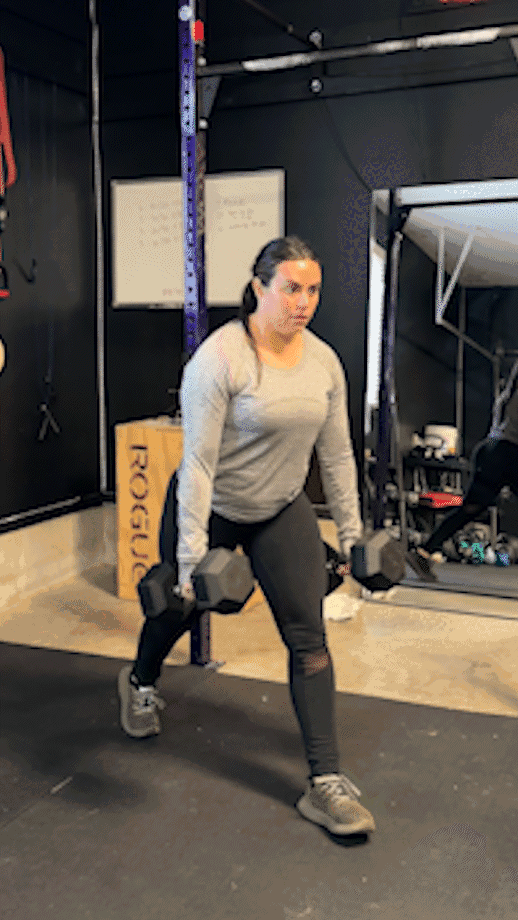
Split Squat: FAQs
What’s the difference between a lunge and a split squat?
The split squat and lunge look similar and target many of the same muscle groups, so what’s the difference? Where the split squat involves a vertical movement pattern, the lunge typically includes front-to-back movement, as is the case with the front lunge, reverse lunge, and walking lunge, or side-to-side movement, as with the lateral lunge.
RELATED: What Muscles Do Lunges Work?
Why can’t I do a split squat?
“Split squats may feel weird if you’re used to regular bilateral back squats,” says Amanda Capritto, CPT, CES, CNC, CF-L1. “If you’re having a hard time doing split squats, it could indicate you have improper foot positioning, insufficient leg or core strength to maintain proper form, mobility issues, balance issues, or something unrelated that’s equally detrimental to your success.”
Consider working with a certified personal trainer, coach, or other qualified fitness professional to find out what’s keeping you from successfully performing split squats.
What are split squats good for?
Like regular squats, the split squat targets lower body muscles, including the glutes, quadriceps, hamstrings, calves, hip flexors and adductors, and more, making them great for building muscle strength, size, and endurance.
The split squat, unlike regular squats, is a unilateral exercise, meaning it’s also good for improving mobility, flexibility, stability, and balance, as well as helping correct muscle imbalances and addressing bilateral deficits.
References
1. Arakawa H, Mori M, Tanimoto M. Greater Hip Moments in Rear-Foot-Elevated Split Squats Than in Conventional Back Squats With the Same Relative Intensity of Loads. J Strength Cond Res. 2023;37(5):1009-1016. doi:10.1519/JSC.0000000000004351
2. Mackey ER, Riemann BL. Biomechanical Differences Between the Bulgarian Split-Squat and Back Squat. Int J Exerc Sci. 2021;14(1):533-543. Published 2021 Apr 1.
Further reading

Ghost reached into the most nostalgic corners of your brain and created a pre-workout with flavors you know by heart, and the energy and pumps you crave. Read more

It’s hard to beat the standard squat when it comes to lower body exercises. This barbell classic provides muscle activation throughout the entire body, predominantly hitting the glutes, quads, hamstrings, and calves, as well as upper body muscles like the shoulders, lower back, and core.The barbell back squat reigns supreme, but that certainly doesn’t mean it’s the only movement worth doing during your leg day workout routine. There are loads of leg exercises to consider, » Read more about: How to Do Split Squats: Nail the Technique to Make Leg Gains » Read more

If you’re wondering, "What muscles do burpees work?" look no further. We list the muscles activated, and explain the benefits of doing this bodyweight exercise. Read more

Dwayne 'The Rock' Johnson seems to do everything big, and his home gyms (yes, he has multiple) are no exception. Read more

